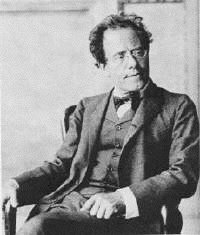
Mahler's farewell However,
though an interesting combination, it would also have made for a rather long
concert (the Mahler runs 90 minutes) which is perhaps why the Haydn was dropped
from the programme somewhere along the way, so that the concert consisted only
of the Mahler. However,
though an interesting combination, it would also have made for a rather long
concert (the Mahler runs 90 minutes) which is perhaps why the Haydn was dropped
from the programme somewhere along the way, so that the concert consisted only
of the Mahler.Mahler was resistant to programmatic interpretations of his work, but knowing the background - his eldest daughter had died of diptheria in 1907 and Mahler himself had developed a heart problem which lead to his death in 1911 and which plainly worried him - it makes perfect sense to interpret the Symphony as a reaction to the strong possibility of death. The first movement is anxious, and the second, though beginning in the form of a cheerful Ländler (a clomping peasant dance) becomes faster and more agitated. The third sounds on the surface like a jolly romp, but rapidly develops uneasy harmonies and becomes increasingly frantic. Only in the final movement, after some referrals back to the uneasiness of the first movement, does the tone finally become reflective and quiet. In such a long work it is essential for the conductor to keep a firm grip: Daniel Gatti. in his last season as Music Director for the Royal Philharmonic Orchestra, and the RPO gave a masterly performance, right through to the long-held and ethereal final passage. One could read this last movement as representing an acceptance of the approach of death: but the incomplete 10th Symphony is altogether darker in tone: so which of them represents Mahler's final thoughts on the subject we shall never know. Posted: Thu - January 15, 2009 at 09:30 AM by Roger Wilmut |
Quick Links
About Me:
Roger Wilmut XML/RSS Feed
MY PODCAST
Archives
Calendar
Blogroll
WEBRINGS
Statistics
Total entries in this category: Published On: Mar 11, 2016 05:00 PM |
||||||||||||||||||


